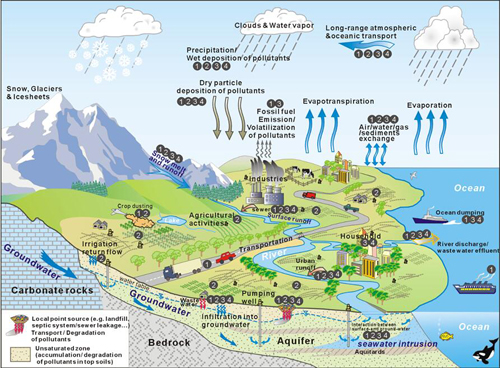
Accompanying rapid industrialisation over the past couple of decades, China has become the world’s largest producer and consumer of inorganic and organic chemicals. At the same time, China’s intensive agricultural sector is a major user of chemical fertilizers and pesticides. A major side effect of these industries is widespread serious water pollution, in both groundwater and surface water. Water pollution poses a serious threat to human and ecological health.
The Chinese Central Government recently released the ‘Ten point plan’ for water pollution control and prevention, in an effort to curb water pollution and improve water quality throughout China. However, comprehensive data on the scale and extent of pollution in ground and surface water basins has to date been limited, making the task of identifying pollution sources and pathways, and cleaning them up more difficult.
Research involving the Institute of Geographical Sciences and Natural Resources Research (IGSNRR) and RMIT University has shed new light on the severity China’s water pollution crisis and the important factors and mechanisms that have contributed to the problems.
The team reviewed the occurrence of persistent organic pollutants (POPs) in China’s waterways – including rivers, reservoirs, lakes, groundwater and marine water. These are toxic compounds that are highly resistant to breakdown in the environment, and can accumulate in ecosystems and humans. The compounds are so far not routinely monitored in China’s waterways.
The review of data from more than 200 published studies found that organo-chlorine pesticides (OCPs) occur in China’s waterways at similar levels to other countries in Asia and around the world. However, polycyclic aromatic hydrocarbons (PAHs) and Poly-chlorinated biphenyls (PCBs) occur at elevated levels relative to other regions of the world for which data are available (e.g. PAH levels were between 15.1 and 72400 ng/L; PCBs between 0.2 to 985.2 ng/L).
Using diagnostic ratios, they found that PAH pollution is largely due to the intensive fossil fuel combustion occurring in China, which is also responsible for chronic air and soil pollution. Serious PCB pollution in China’s waterways appears to be due to emissions and waste from China’s intensive manufacturing sector, as well as global trade in e-waste, which results in hazardous materials being shipped to China.
“Areas of China with particularly serious POPs pollution include the Yangtze River basin, Pearl River Delta and Zhejiang province. These are all areas of intensive industry, including manufacturing and chemical industries, in China’s southeast. Strategies for mitigating POPs in China's waterways should be discussed and implemented”, said HAN Dongmei, associate professor of IGSNRR.
In a related paper, the researchers explore the international links to China’s water pollution crisis. It describes how rapid growth of China’s economy in the early 21st century was linked to it becoming an international destination for many energy intensive and polluting industries, contributing to the pollution China currently faces.
The study results show how ‘displacement of environmental harm’ across international boundaries was encouraged by trade agreements and policies of the international community and China. The‘winners and losers’ from these developments are examined, in the context of major ongoing health and environmental impacts in China.
 |
|
Figure 1–Schematic figure showing sources and transport processes for persistent organic pollutants, and their interaction with the hydrological cycle. Numbers indicate classes of POPs reviewed in this study; 1 = Polycyclic aromatic hydrocarbons (PAHs); 2 = Organochlorine pesticides (OCPs); 3 = Polycholorinated Biphenyls (PCBs); 4 = Perfluorinated compounds (PFCs). (Image by HAN Dongmei) |

86-10-68597521 (day)
86-10-68597289 (night)

86-10-68511095 (day)
86-10-68512458 (night)

cas_en@cas.cn

52 Sanlihe Rd., Xicheng District,
Beijing, China (100864)

